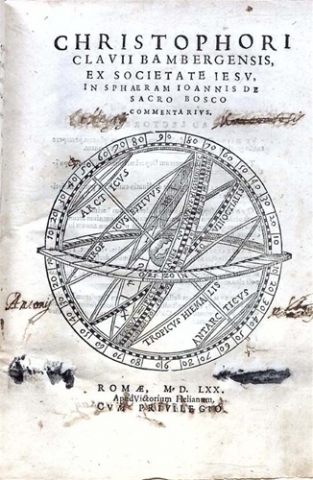In Sphaeram Ioannis de Sacro Bosco Commentarius
Christophori Clauii Bambergensis, ex Societate Iesu, In sphaeram Ioannis de Sacro Bosco commentarius
This first edition of Clavius's commentaries on Sacrobosco's Sphaera opens a fascinating window into the transitional time period of the early scientific revolution: the change from the earth-centered to the heliocentric world view, from Ptolemaism to Copernicanism. The basic text of this book, Joannes de Sacrobosco's (fl. ca. 1230) Sphaera was the most widely used astronomical resource of the late Middle Ages and the Early Modern Period and went through literally hundreds of editions inspiring many commentaries. Although the end of the Ptolemaic era was marked by Copernicus's revolutionary work, De revolutionibus (1543), it was not until the publication of Kepler's Astronomis nova (1609) and Galileo's Sidereus nuncius (1610) that the heliocentric theory began to achieve broader acknowledgement. The period between 1543 and 1610, as a result, is a particularly fascinating one. Tycho Brahe (1546-1601) still represented a geo-heliocentric system and Johannes Kepler (1571-1630) and Galileo began his observations and researches continuing the work of Copernicus. Clavius, meanwhile, was the most compelling astronomical voice in support of geocentricism.
Christoph Clavius (1538-1612), was perhaps the most distinguished mathematics professor of his generation at the Collegio Romano, the principal Jesuit seminary and college. He produced two extremely popular textbooks and he also served on the papal commission on calendar reform that would produce the Georgian calendar. After Galileo visited Clavius in Rome in 1587 they corresponded and Clavius, cautiously though, but mentioned in the later editions of his commentaries on the Sphaera, the new invention, the telescope. He also described there some of the observations Galileo made with the telescope, such as about the "roughness" of the surface of the Moon, and the moons ("stars") of the Jupiter. Clavius's edition of the Sphaera was an extremely important book, and according to modern historians is the "greatest of all Sphere commentaries" (Lattis, Between Copernicus and Galileo, p. 37). The copy the Smithsonian Libraries has purchased bears extensive marginal annotations and intertextual mathematical calculations of several early readers, and would doubtless reward further study.
The book is richly illustrated. A woodcut of armillary sphere decorates the title-page, three half-page and many smaller woodcut illustrations and diagrams are in the text. There are also woodcut initials of various sizes and styles.
Discover more about this book in our Catalog.
Adoption Type: Build and Access the Collection

